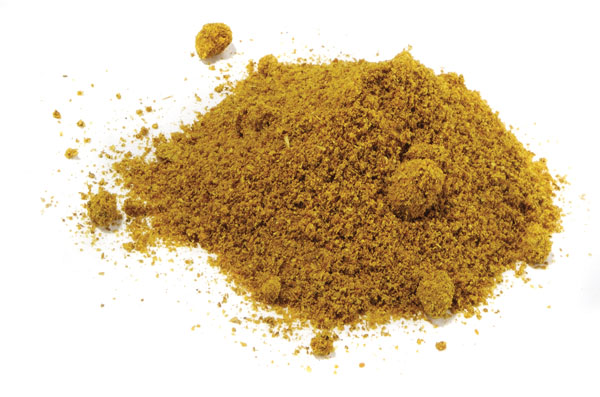Discover
 PATENTLY SPICY: Rochester scientists have received a patent to use compounds derived from curcumin to fight cancer, acne,
baldness, and other conditions. (Photo: iStockphoto)
PATENTLY SPICY: Rochester scientists have received a patent to use compounds derived from curcumin to fight cancer, acne,
baldness, and other conditions. (Photo: iStockphoto)It may be the Peyton Manning of prostate cancer: a protein called paxillin that’s essential for the disease to grow and spread throughout the body.
Like any good quarterback, paxillin commands the entire field, controlling cell growth in tumors sensitive to hormone therapy and in tumors that grow resistant to such treatment.
Though in the very early stages, the discovery that paxillin is a major player in prostate cancer is an important first step toward developing a treatment for men whose cancer persists even after the most aggressive treatment. The research was published in the Journal of Clinical Investigation.
“The holy grail in prostate cancer is to figure out why cells stop responding to hormone therapy,” says senior study author Stephen Hammes, the Louis S. Wolk Distinguished Professor in Medicine and chief of the Division of Endocrinology and Metabolism in the Department of Medicine.
Hammes and first author Aritro Sen, research assistant professor in the Division of Endocrinology and Metabolism, found that paxillin can go into the nucleus of a cell, regulating signals that lead to the creation of cancer cells. Taking paxillin out of the nucleus brought growth to a halt in both hormone-therapy-dependent and resistant prostate cancer cells.
What Does It Mean to Be Cool?
 REBELLIOUS: In 1955, James Dean was the very definition of cool in Rebel Without a Cause. (Photo: Corbis/Sunset Boulevard)
REBELLIOUS: In 1955, James Dean was the very definition of cool in Rebel Without a Cause. (Photo: Corbis/Sunset Boulevard)Research led by a Medical Center psychologist and published by the Journal of Individual Differences has found the characteristics associated with coolness today are markedly different from those of the past.
“I was not prepared to find that coolness has lost so much of its historical origins and meaning—the very heavy countercultural, somewhat individualistic, pose,” says Ilan Dar-Nimrod, a postdoctoral fellow in psychiatry, who led the study.
Coolness now is not so broody, he says. “The much darker version of what coolness is, is still there, but it is not the main focus. The main thing is: Do I like this person? Is this person nice to people, attractive, confident, and successful?”
Dar-Nimrod and his colleagues recruited almost 1,000 people who completed a questionnaire on the attributes, behaviors, and individuals they associated with the word “cool.” A significant number of participants used adjectives that focused on positive traits, such as “friendly,” “competent,” “trendy,” and “attractive.”
The findings could point to possible health implications, says Dar-Nimrod, whose main research interests are the effects of genetics and social environment on decision making and health behaviors. “Smoking or drug use, for example, could be connected with a view of coolness that includes rebelliousness or a countercultural stance. This can inform future health research on behaviors.”
Mathematicians Hide Waves Inside an Invisible ‘Hat’
Is invisibility, once the stuff of stories, slowly becoming reality? Over the past five years, mathematicians and other scientists have been working on devices that shield small objects from detection by microwaves or sound waves.
Allan Greenleaf, professor of mathematics, and an international team of researchers have come up with a process that would allow practical applications to be performed in a cloaked—or invisible—environment. The findings have been published in the Proceedings of the National Academy of Sciences. Such a
cloak could hide a probe needed to take precise sound measurements while letting in just enough sound waves that could be amplified for taking measurements. They’ve dubbed the system “Schrödinger’s hat,” in reference to the famed Schrödinger’s cat of quantum mechanics.
Patenting Curry’s Power Against Disease
The University and two other entities have received a U.S. patent for the use of compounds related to curcumin, the main ingredient of curry, in the fight against cancer, acne, baldness, and other medical conditions.
The patent—also awarded to the University of North Carolina at Chapel Hill and to AndroScience Corp. of San Diego—is for research led by Chawnshang Chang, director of the George Whipple Laboratory for Cancer Research at the Medical Center and a cofounder of AndroScience, in which the University owns a stake.
Chang, a faculty member in the Departments of Urology and Pathology and the James P. Wilmot Cancer Center, is one of many researchers worldwide investigating the potential biomedical benefits of curcumin, the spice that gives mustard and curry their bright yellow colors. Two dozen patents, dating back to 2004, have been issued to the University for Chang’s work.
“It’s exciting and gratifying to be part of the broad effort to learn about how compounds like ginger and curcumin exert potential health effects, which are well recognized in China and other cultures, and try to harness them to treat people with diseases like prostate cancer,” says Chang.
New Huntington Treatment Shows Promise
A new Rochester study indicates that the compound coenzyme Q10 (CoQ) reduces oxidative damage, a finding that hints at its potential to slow the progression of Huntington’s disease. The discovery, which appeared in the inaugural issue of the Journal of Huntington’s Disease, also points to a new biomarker that could be used to screen experimental treatments for the debilitating disease and other neurological disorders.
“This study supports the hypothesis that CoQ exerts antioxidant effects in patients with Huntington’s disease and therefore is a treatment that warrants further study,” says Kevin Biglan, associate professor of neurology and lead author of the study. “As importantly, it has provided us with a new method to evaluate the efficacy of potential new treatments.”
Huntington’s disease is a genetic, progressive neuro-degenerative disorder that affects movement, behavior, and cognition and generally results in death within 20 years of the disease’s onset. Scientists believe that one of the important triggers is a genetic “stutter” that produces abnormal protein deposits in brain cells—deposits believed to inhibit the ability of cells to meet their energy demands. The result is oxidative stress— and, ultimately, cellular death. —Mark Michaud

